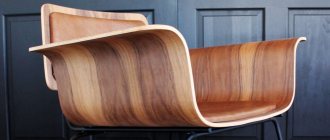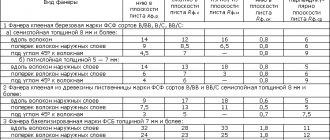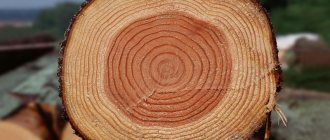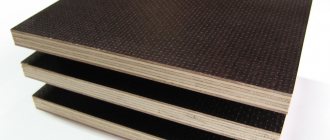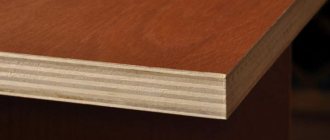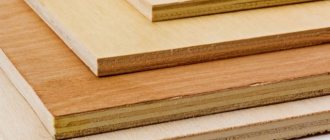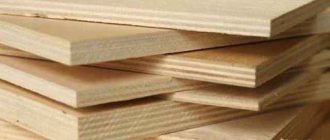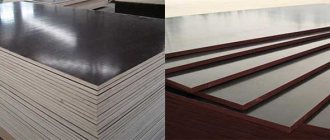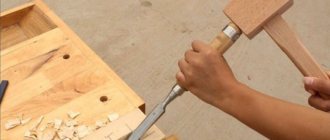The choice of materials in construction is an important stage on which the quality of the entire finished object depends. Often you have to look for materials that combine quite different characteristics, such as strength and light weight.
For finishing buildings, plywood glued together from several layers of veneer or tree bark is widely used. Features of the selection and use of plywood in different industries are worth a detailed analysis.
Dividing plywood by type of wood
The properties of the material greatly depend on the type of wood, but for plywood only the veneer composition of the outer layers of the sheet is taken into account.
Based on the type of wood, plywood is divided into 3 categories:
- Birch. 90% consists of birch shavings and sawdust. It has a pleasant light shade with a uniform soft texture and high tensile strength.
- Coniferous. Consists of coniferous wood. It is characterized by increased resistance to moisture and insects due to the resins in the fiber structure, while the resin is often found in the texture in the form of noticeable resin pockets.
- Combined. It consists of wood of different species, partly made from especially valuable wood species. It is characterized by increased strength, but due to the technological complexity of production and the partial content of valuable species in the composition, it has a high price.
Facing
Applications of different types of plywood.
Facing plywood consists of peeled veneer. One or both of its sides are made with a sanded surface so that the sheets can be used for finishing cladding. Depending on what kind of glue is used in manufacturing, products are divided into FOC with urea-formaldehyde glue and FOC with phenol-formaldehyde glue. Only grades I and II are produced. Sheets are radial, semi-radial, tangential-end, tangential.
The surface can be polished or unpolished. The strength is 0.6-1.2 MPa, which is enough to perform even complex work. There is a type of decorative plywood (has a layer of paper) used for interior work. This material comes in the following types:
- DF-1,3 with a colorless or colored layer;
- DF-2 with opaque coating;
- DF-4 with a pattern imitating the surface of wood.
Plywood can be lined with other materials. For example, fire-resistant or ordinary plastic, fiberboard, fiberglass material. Thickness is 10mm, 12mm, 15mm, 18mm. There is plywood lined with metal and PVC film. It all depends on the requirements for the finishing and the plywood itself.
Classification of plywood by grade
The grade of plywood refers to the overall quality of the wood, the degree of its processing and the presence of visual defects.
Plywood is generally divided into 5 grades:
- Grade E. Selected plywood with a perfectly smooth surface and without visual defects. Only minimal deviations from the original structure of the wood itself are allowed.
- Grade 1. High-quality plywood with minor defects (warping and cracks).
- Grade 2. Medium quality plywood with permissible cracks up to 200 mm and glue protrusion of no more than 2% of the total surface area.
- Grade 3. Rejected plywood of average quality, which may contain small wormholes and cracks up to 300 mm long.
- Grade 4. Low quality plywood with a large number of acceptable visual and structural defects.
By the way! You can often see the markings “4/4” or “3/4”, this is how the sides correspond to a certain grade: the first number is the grade of the front layer, the second number characterizes the back layer. It is beneficial to use such plywood for interior decoration.
Types of plywood for finishing
Among the sheets used in construction, there are five types of plywood:
- Grade E is the highest quality option. Such plywood does not have any harmful impurities in its structure, is not deformed and has a smooth surface.
- Grade 1 plywood sheet allows for a small number of inclusions, but the quality is also at the highest level.
- Grade 2 is characterized by additional inclusions no more than 2 cm in length; this material is of good quality. This type can be used for cladding.
- Grade 3 allows for up to 10 wormholes, their length varies within 0.5 cm.
- Grade 4 is the lowest, used mainly for technical work. It is characterized by a large number of defects that do not in any way affect the quality of the product, but rather the appearance.
Separation of plywood according to surface treatment method
A number of manufacturers, in addition to the grade, additionally indicate the method of processing the surface layer when marking plywood. Plywood is divided into 4 categories based on surface type:
- Laminated. The sheet is covered with a special film for additional protection and increased strength.
- Ш2. Plywood, sanded on both sides.
- Ш1. Plywood, sanded on one side.
- NS. Plywood that has not been sanded.
Reinforced
If it is necessary to strengthen the slab and provide any special properties, then reinforced plywood is used. It has a complex structure, and the veneer inside can be replaced with layers of rubber, metal foil, and a special mesh. This increases not only strength, but also rigidity, which is necessary during construction work. The mass of the sheets remains almost unchanged. This is especially important when arranging floors. Sheet rubber in the material makes it possible to improve the quality of the fabric and increase the elasticity of products, while moisture permeability and air permeability become less strong. The appearance of plywood does not change, working with it remains just as simple.
When choosing plywood, you need to pay attention to the classification of this natural material. Not only the materials of manufacture are taken into account, but also the type, quality and grade of sheets. Plywood can be differentiated by purpose: for construction, for facing work, for general purpose. To make the right choice, you need to study the characteristics of each variety.
Classification of plywood by adhesive composition
The composition of the glue greatly affects the characteristics of the plywood sheet, so plywood is also distinguished on this basis:
- FSF. Plywood based on phenoformaldehyde glue. It is characterized by increased moisture resistance and strength. The resin composition includes harmful substances, which is why FSF is not recommended for use in finishing residential premises and making furniture.
- FKM. Plywood based on melamine glue. Average level of moisture protection and concentration of harmful substances in the adhesive. A universal type of plywood that can be used where there are no special requirements for moisture resistance and toxicity levels.
- FC. Plywood based on urea glue. The composition of the glue is absolutely harmless to humans, but does not provide the wood with high moisture resistance. An ideal plywood option for interior decoration.
- FBA. Plywood based on albumin casein glue. Environmentally friendly composition with the worst moisture resistance indicators. FBA plywood is only suitable for work in dry rooms.
- FB. Plywood based on bakelisite glue. An expensive and versatile option with a high level of moisture resistance and strength. Bakelite plywood is further divided into 2 categories: FBS. Contains alcohol-soluble glue, which provides better moisture resistance of plywood.
- FBV. It contains water-soluble glue, which further strengthens the structure of the sheet and ensures high strength of the plywood.
By the way! Plywood markings may vary depending on the method of processing the layers with glue. For example, in FBV-1, the veneer layers are not impregnated with the composition, but are only coated. And in “FBS-1A” only the longitudinal layers are treated with glue. Therefore, if you see such markings, you should know that the quality of such plywood will be slightly lower.
How does laminated plywood differ from regular plywood?
It may seem that the only difference between laminated material and ordinary plywood comes down to the fact that the front and back surfaces are covered with a protective waterproof film to enhance resistance to moisture. The same information can be found in most building materials stores, and even representatives of the laminated plywood manufacturer Svez use a similar technical description of the material.
It will be useful for all self-builders to know that the conditions and the process of manufacturing laminated plywood are somewhat different from the method of producing ordinary plywood boards, and accordingly, the technical characteristics are also different.
Below are just some of the characteristics that are defined by GOST R No. 53920-2010:
- For the production of laminated boards, grade 1-2 plywood is used, with a phenol emission class of E1, and strict requirements are established for the presence of defects on the surface of the veneer, the gluing method and the final density of the material.
- The coating of the laminated surface can be made of thermosetting plastic or polymer film with high strength characteristics. According to the test conditions, the characteristics of the coating must remain unchanged during six hours of boiling in water, in contact with an alkaline environment or liquid concrete.
For your information! Phenolic-resol resins, or, in common parlance, bakelite, are used as an impregnating and adhesive material.
Laminated plywood, unlike bakelite plywood, is hot-impregnated and contains several times less phenol.
The result is a fairly strong and at the same time elastic material, with a laminated protective layer of polymer. Waterproof laminated plywood turns out to be more plastic than bakelite board, which is superior to laminated samples in its technical characteristics of water resistance, but at the same time has increased sensitivity to impacts and abrasive wear in a humid environment.
To produce a laminated coating for plywood, in addition to phenol-formaldehyde resin and textured paper, melamine varnishes and polyvinyl chloride films are used. The technical characteristics of melamine coating and PVC are somewhat worse than those of FFS, but they are indispensable in the production of colored laminated plywood. If an ordinary laminated material according to the phenol emission class E1, according to the technical characteristics of GOST, can release 0.120-0.124 mg/m3 into the air, then painted samples with PVC coatings emit an order of magnitude lower doses of the toxic substance.
According to the technical characteristics and method of application of GOST, waterproof laminated plywood 21 mm and 18 mm is used as exterior finishing and material for the manufacture of cast concrete molds. Painted laminated plywood 18 mm can be used for interior finishing work, cladding walls of frame houses and as a sublayer for leveling floors.
It is quite simple to distinguish an ordinary laminated board from a painted one - by the color of the coating; the standard version is dark brown, while colored ones are tinted in lighter shades.
Dimensions and thickness of plywood
The dimensions and thickness of plywood are regulated by GOST 3916.2-96 (for coniferous panels) and GOST 3916.1-96 (for hardwood grades). At the same time, the standard sheet width is 1220 mm; plywood 1525 mm wide is also often used. The length of plywood varies from 1525 mm to 2500 mm. Standard sheet size: 2440x1220 mm, and the most popular size: 1525x1525 mm.
The thickness of plywood depends on the raw material and the number of veneer layers (from 3 to 21) and ranges from 3-30 mm.
Application of general purpose plywood products
General purpose plywood is used in the furniture industry, in construction - as a finishing material and as structural or auxiliary products. The grade of products does not affect their strength. For finishing work, sheets of grade E or 1 are used as front panels: the ideal pattern makes these products suitable for cladding walls “like wood”; Using stains and varnishes, the surface of high-quality veneer can be given the appearance of valuable types of wood.
Plywood 4 mm 2/2 is a second-class product, the front and back surfaces of which are distinguished by a minimum amount of damage, cracks, and knots. In most cases, knots and obvious wormholes are sealed with veneer inserts, which makes it possible to use this material as a front finish. Plywood 4 mm 2nd grade, coated with decorative paints and varnishes, is used for cladding walls in modular houses; Furniture cases and panels are made from it.
Plywood 3 mm 2/2 is the thinnest material offered by the industry; is one of the most common. It has high elasticity, low weight and sufficient decorative properties. The sheets are used to make substrates for decorative sandwich panels - floor and wall coverings. In furniture production, three-millimeter sheets are used as back panels, sliding drawer bodies, and adhesive bases. This plywood is often used for the manufacture of container products - parcel boxes, suitcases, and traveling bags.
Methods of using plywood
Different classifications and characteristics of plywood open up many possibilities for the use of plywood in a particular industry.
Marine/Marine Plywood
For finishing yachts, boats and during construction work, where special strength and the ability to withstand prolonged exposure to moisture are required. For these purposes, mainly birch FB plywood is used.
Furniture plywood
For the production of furniture, preference is given to birch FC plywood, since it is harmless to the human body. Our blog has an article about making a kitchen out of plywood with your own hands.
Construction plywood
For construction work, low-grade plywood is mainly used, since it is used in large quantities for rough installation, where appearance is not so important.
Aviation plywood
A special type of ultra-strong FSF plywood for aircraft construction, professional modeling, and the production of musical instruments.
Plywood for formwork
Formwork can be made from any plywood, but only thick sheets of laminated FB plywood are suitable for reusable use.
Decorative plywood
Selected high-grade FC plywood, from which only perfect appearance and smooth surface are required. It is used for interior decoration, upholstery of car interiors and furniture production.
Transport plywood
Laminated plywood with ribbed and mesh coating is used in the automotive industry. The use of such plywood when covering the metal frames of vans and in interior trim helps to significantly reduce the weight of the vehicle, and also simplifies and reduces the cost of repairs.
Manufacturing of laminated plywood
Now a few words about what lamination is.
In the process of this action, various compositions are used:
- Melamine. It contains melamine-formaldehyde compressed resins. This substance consists of a group of aminoplasts and forms a water-repellent, durable coating on the surface of the product;
- Phenol. This chemical compound is a constituent of certain organic resins used in the production of wood plywood;
Important! This kind of lamination provides a lower degree of moisture repellency.
- PVC (polyvinyl chloride).
This is the most popular material for lamination, as it has:
- Excellent technological characteristics;
- Low chemical activity.
Thanks to the coatings described above, plywood laminated with polyvinyl chloride is recommended for use in interior decoration and the production of furniture.
Production facilities with fully automated processes
Factory production of laminated plywood consists of covering both sides with thick paper impregnated with one of the above compounds.
The lamination process is carried out using:
- Presses with heated polished plates;
- Press gaskets made of brass.
It happens in the following order:
- Plywood with layers of laminate applied is placed in a press;
- Bonding of the laminating layer to the wood board occurs under the influence of high temperatures;
- The material is then removed from the press to cool;
- Cooled products are sorted, and markings are applied based on the inspection results.
